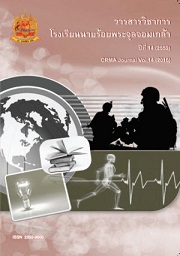ผลของการใช้ไมโครเวฟร่วมกับสุญญากาศในการอบแห้งสับปะรด (กรณีศึกษา:กำลังไมโครเวฟ)
Main Article Content
บทคัดย่อ
งานวิจัยนี้เป็นการทดลองอบแห้งสับปะรดโดยใช้ไมโครเวฟร่วมกับสุญญากาศในกระบวนการอบแห้ง โดยทำการศึกษาอิทธิพลของกำลังไมโครเวฟที่ส่งผลต่อการกระจายอุณหภูมิ ความชื้นและเวลาที่ใช้ในการอบแห้งสับปะรด โดยใช้ไมโครเวฟร่วมกับสุญญากาศ ที่กำลังไมโครเวฟ 800 W และ 1,600 W ความดันสุญญากาศที่ 30 kPa วัสดุที่ใช้ในการทดลองคือ สับปะรดพันธุ์ ศรีราชา ที่นำแกนออก มีขนาดเส้นผ่าศูนย์กลางภายนอก 65 mm เส้นผ่าศูนย์กลางภายใน 25 mm ความสูง 10 mm อบแห้งสับปะรดครั้งละ 1 kg ที่ความชื้นเริ่มต้นของสับปะรด 80%wb จนกระทั่งมีความชื้นสับปะรดที่ 20%wb กำหนดให้ควบคุมอุณหภูมิภายในห้องอบที่ 70ºC จากผลการทดลองพบว่า กรณีกำลังไมโครเวฟ 1,600 W ใช้ระยะเวลาในการอบแห้งที่สั้นกว่า สามารถไล่ความชื้นเร็วกว่ากรณีกำลังไมโครเวฟ 800 W แต่ได้ด้านของคุณภาพของผลิตภัณฑ์ หลังผ่านกระบวนการอบแห้งพบว่ากรณีกำลังไมโครเวฟ 800 W ให้คุณภาพทางด้านลักษณะทางกายภาพที่ดีกว่ากรณีกำลังไมโครเวฟ 1,600 W
Article Details
ผลงานที่ได้รับการตีพิมพ์ ถือเป็นลิขสิทธิ์ของวารสารฯ
เอกสารอ้างอิง
Shivhare, U.S., Raghavan, G.S.V., Kundra, T., Mujumdar, A.S. and Van De Voort, F.R.,1991. Through-circulation microwave drying of corn, Drying, 91:414-422.
Tulasidas, T.N., Raghavan, G.S.V., van de Voort, F. and Girard, R.,1996. Dielectric properties of grapes and sugar solutions at 2.45 GHz, Journal of Microwave Power and Electromagnetic Energy, 30 (2): 117-123.
สุวิมล เสนีวงศ์ ณ อยุธยา,ธีรพจน์ เวชพันธุ์, ไชยณรงค์ จักรธานนทร์ และผดุงศักดิ์ รัตนเดโช (2009).การศึกษากระบวนการทำความร้อนในชั้นวัสดุที่เป็นของเหลวโดยใช้คลื่นไมโครเวฟติดท่อนำคลื่นรูปทรงสี่เหลี่ยม (โหมด TE10) ใช้แบบจำลองทางคณิตศาสตร์แบบสามมิติ. วารสารวิชาการโรงเรียนนายร้อยพระจุลจอมเกล้า. หน้าที่ 210-219.
Christine H. Scaman, Timothy D. Durance, Liana Drummond, Da-Wen Sun. 2014, Chapter 23 - Combined Microwave Vacuum Drying, Emerging Technologies for Food Processing (Second Edition), 427-445.
Maskan, M. 2000, Microwave/air and microwave finish drying of banana, Journal of Food Engineering, 44, 71-78.
Soysal,Y., 2004, Microwave drying characteristicS of parsley, Biosystems Engineering, 89(2), 167-173.
J. I. Wadsworth, L. Velupillai, L. R. Verma, 1990. Microwave-vacuum drying of parboiled rice, Transactions of the ASAE. 33 (1): 199-210.
Drouzas, A.E., Tsami, E. and Saravacos, G.D.,1999. Microwave/Vacuum Drying of Model Fruit Gels, Journal of Food Engineering, Vol. 39:117-122.
Kusturee Jeni, Mudtapha Yapa, Phadungsak Rattanadecho, 2010. Design and analysis of the commercialized drier processing using a combined unsymmetrical double-feed microwave and vacuum system (case study: tea leaves), Chemical Engineering and Processing 49 :389–395.
Arnold R. Elepaño and Karen T. Satairapan, 2001. A SOLAR-BIOMASS DRYER FOR PINEAPPLE. Philippine Society of Agricultural Engineers, National Convention held in Cebu Plaza Hotel, Cebu City.
G.E. Botha, J.C. Oliveira, L. Ahrné , 2012, Microwave assisted air drying of osmotically treated pineapple with variable power programmes, Journal of Food Engineering, 108 (2) : 304-311.
Pedro Amorim Berbert, Marcia Terezinha Ramos de Oliveira, Ana Paula Martinazzo, 2016. Drying of pineapple slices in natura and pre-osmodehydrated inatura and osmodehydrated pineapple slices in inverted sugar. Bioscience Journal, 32(3): 597-610.
Ratanadecho,.P.,Aoki,K.and Akahori,M., 2001, Experimental and Numerical Study of Microwave Drying in Unsaturated Porous Material. Int. Commune, Heat Mass Transfer, Vol.28 :605-616.


